WEBLOG:
Elena and I just returned from our trip to Taiwan. We first went to Hong Kong for a couple of days, then to Taiwan for a week. We’ve been to Hong Kong many times before, and we mostly stopped by to visit a friend and also to take care of some Taiwan-entry paperwork.
My mother bought a home recently in Taipei, so we stayed with her. We walked all day every day while we were there, and my feet hurt so bad that sometimes I didn’t think I could take another step. For the last couple of years, I rarely went out, so my feet were not used to walking so much. We also ate so much, since Taiwan is famous for its street food vendors and variety of local, foreign, and fusion cuisine. It’s impossible to not stuff yourself when you visit the night markets, which we did almost every night. This is what the night markets look like:
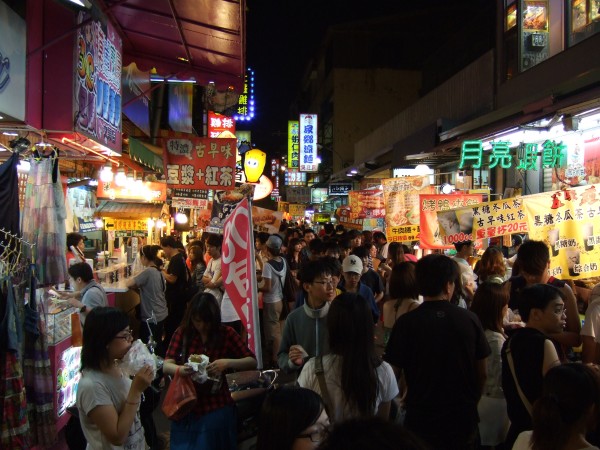
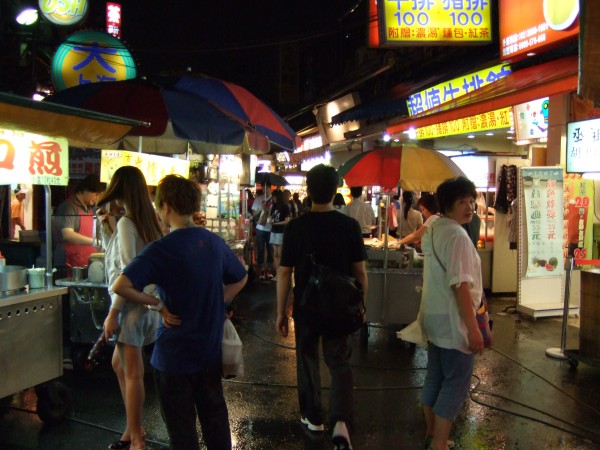
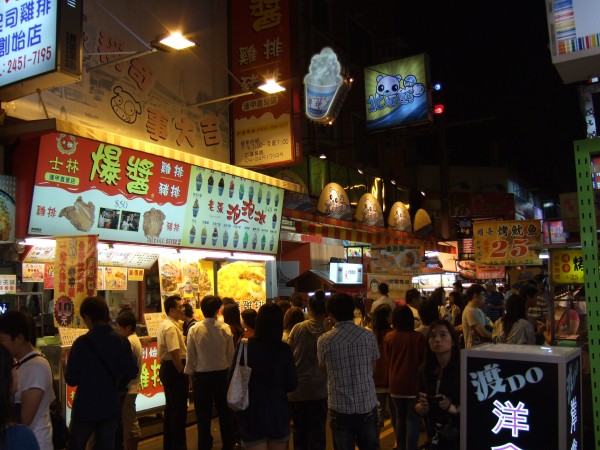
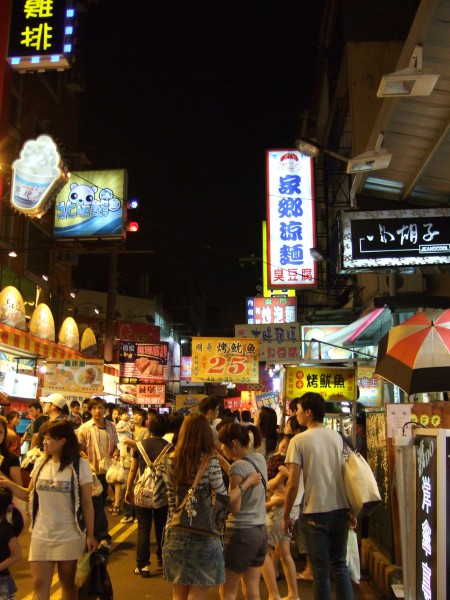

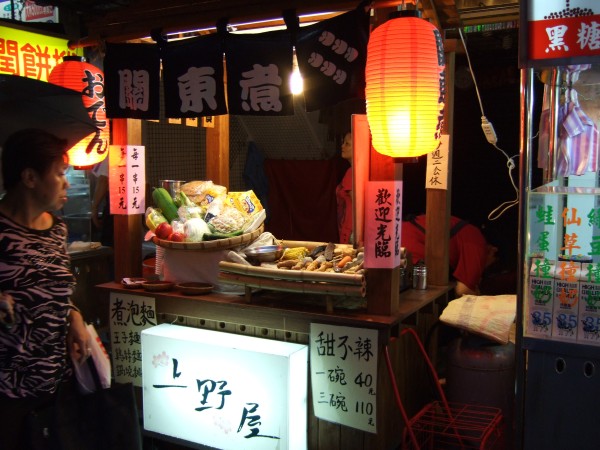
We don’t usually eat Chinese food when we go out (unless another person in the party prefers Chinese), since we love to try food from different cultures, and Taiwan is relatively cosmopolitan (though not to the degree that Hong Kong is) in terms of having different cuisines and inventing their own fusion cuisines that borrow from other cultures:
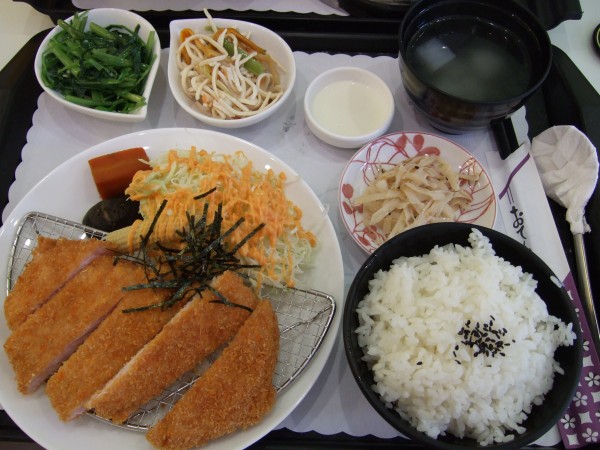
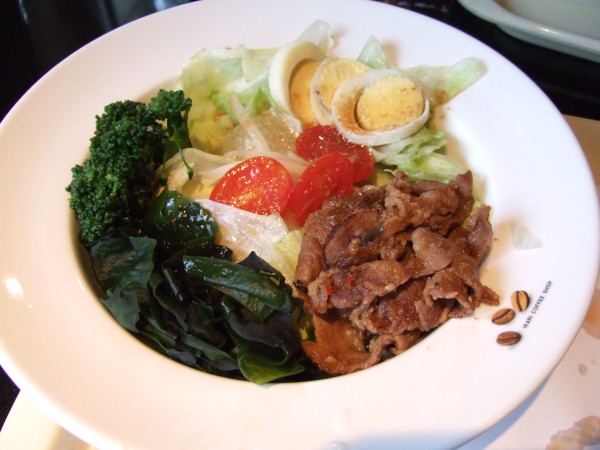


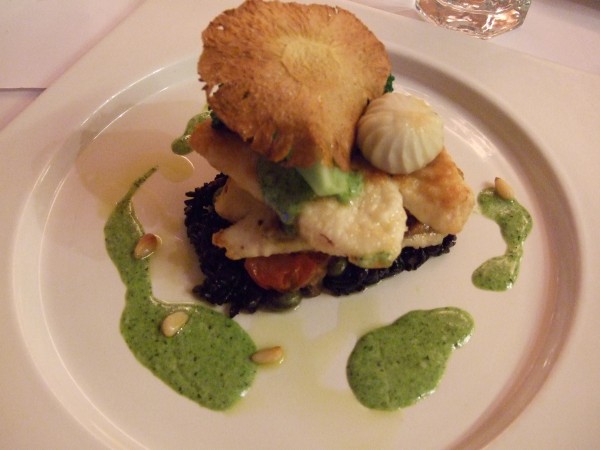

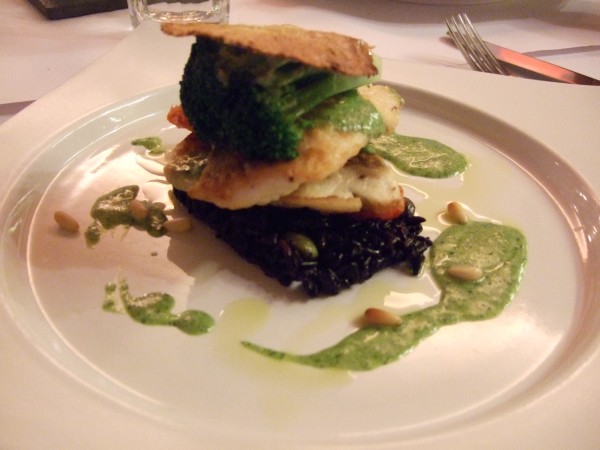
As you can see, western cuisine is readily available in Taiwan, and it’s authentic and tasty, not like the crap you get in China where they alter western food so much that it tastes like some kind of indistinct and bland crap that masquerades as western cuisine, but in reality is anything but. Other Asian cuisines like Japanese, Korean, Thai, Indian…etc are also readily available in Taiwan, and it’s all good.
Taiwan is known for having an abundance of yummy fruits, and that is reflected in the many street food vendors selling beautifully cut and delicious fresh fruits (and they really are delicious–to the point where I wondered if additional flavoring was added, like sweetening). It’s also amazing that all the fruits were absolutely flawless–not a single one had less than perfect coloring, shine, or ripeness. Here’s what one of these fruit stands look like:
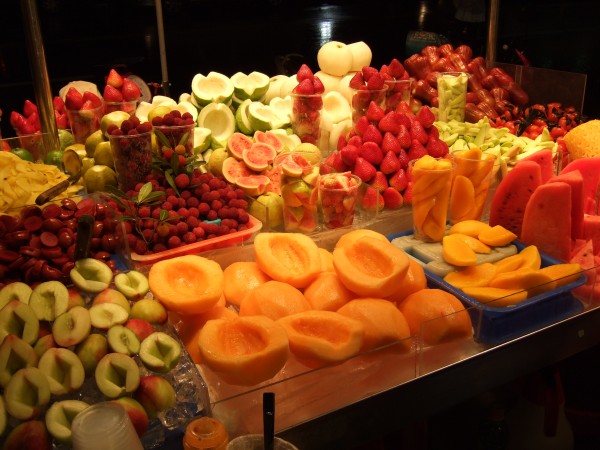

There’s even bitter melon juice, which intrigued me since I normally hate bitter melon due to its horribly bitterness. Turned out there’s a special kind in Taiwan that’s white (it’s usually green) and it’s not nearly as bitter (in fact, it has a sweet aftertaste), while still maintaining the same health benefits (which is to “cool down” your system):

If you have never heard of it before, the whole concept of foods being “warm” or “cool” is a concept in Chinese medicine (it has nothing to do with temperature, but the “qi,” or energy) where the different energies of food are like ying and yang, and you have to balance them in your diet. When you eat too much warm foods, you might get sores in your mouth, nose bleeds, and other symptoms, which you then counter with cool foods. But if you have a weak digestive system, cool foods will only make it worse, so you have to eat warm foods. I’m on the fence in general about Chinese medicine, as some of it really does seem to work, and does things that western medicine can’t do, while some of it just seems like superstition B.S. to me.
Taiwan has famous local delicacies–one like like sticky rice with pig’s blood (one of my favorites), oyster noodles, braised pork rice…etc. Of course, the famous bubble tea is a Taiwan invention as well. Here’s the stinky tofu, which is another one of its famous local delicacies:

When we went to the Cold Stone Creamery, we saw some interesting local creations like these:
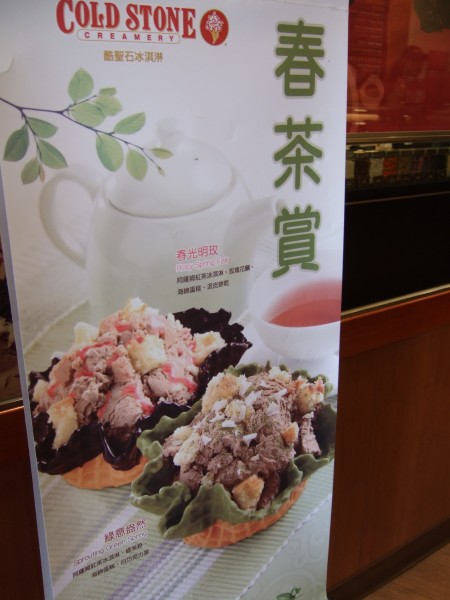
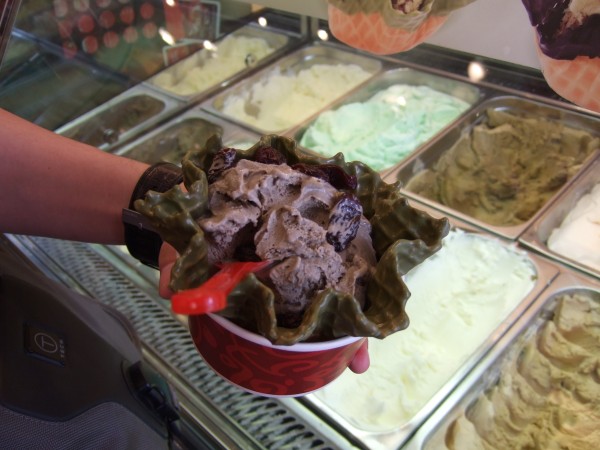
Taiwan’s shaved ice desserts are also quite famous:
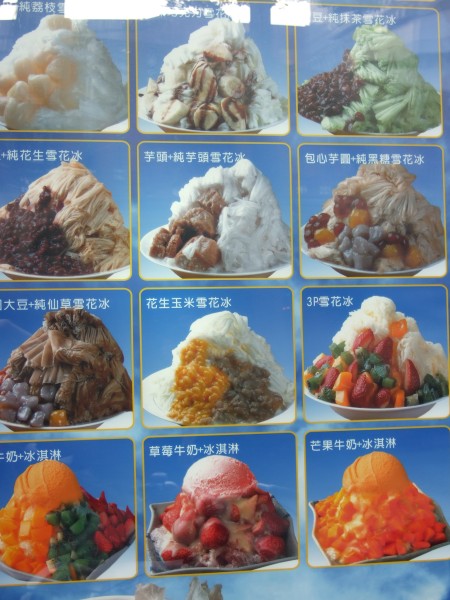
Asian’s love tea-flavored desserts, as well as sweet red beans, plums, ginger, taro (ube), sweet potatoes, condensed milk, mangoes, peanuts, bubble jelly, brown sugar, lychee, passion fruit…etc, as shown in the photo above, and the Asian variants of Cold Strone Creamery creations generally fall along those lines too.
Other than being tasty, food in Taiwan is also far safer than the toxic crap in China, and it’s also quite cheap, so you can really eat until you burst and your wallet would barely feel the impact, although your stomach surely will.
While strolling through one of the night markets, we saw this cozy little square–it reminded me a little of bit places like the Ghirardelli Square in San , except much more modest:
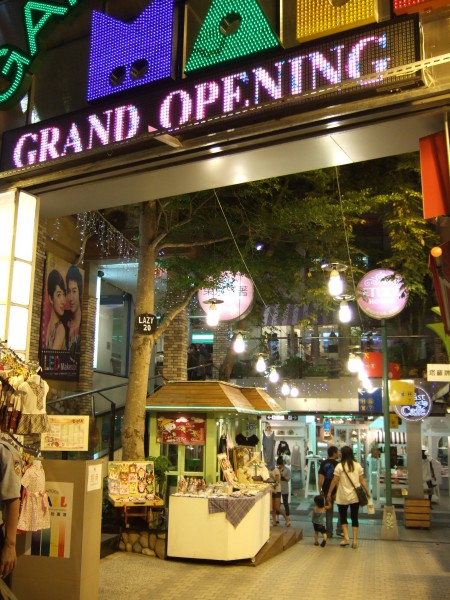
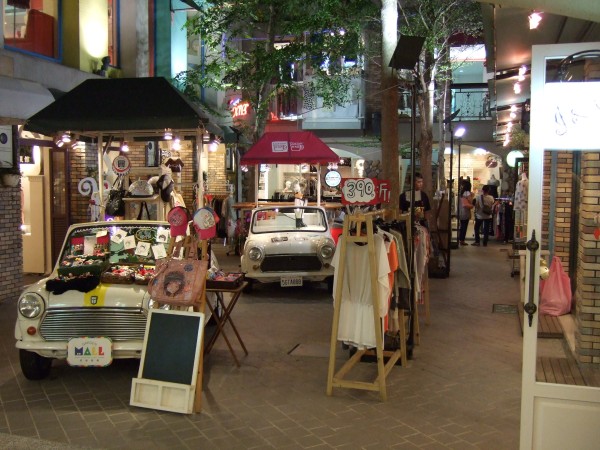
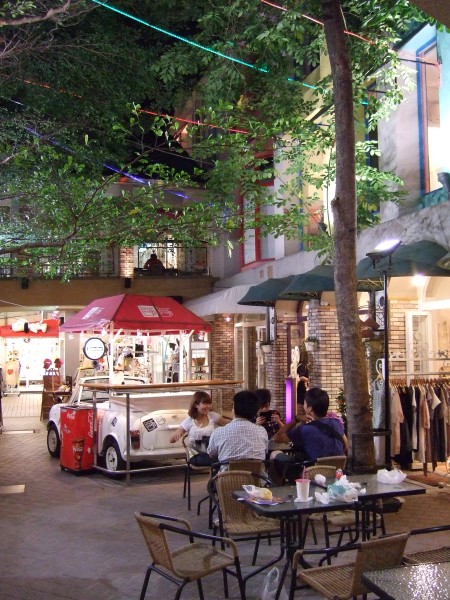
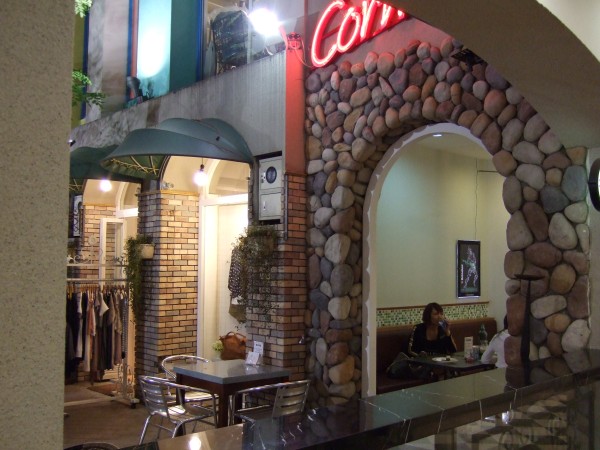
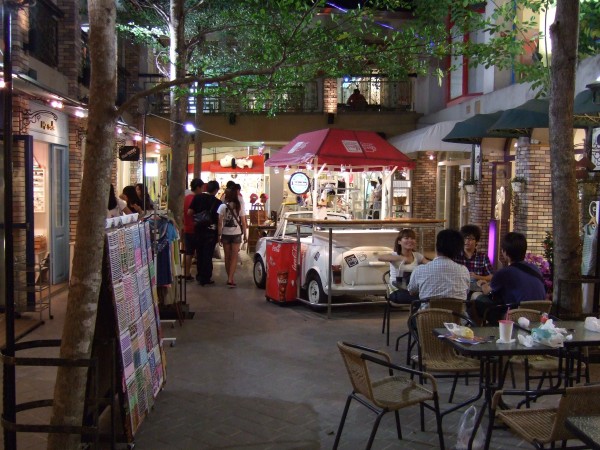
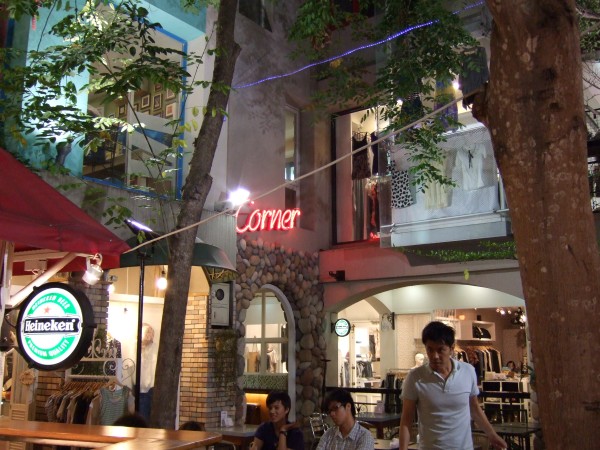
Taiwan’s been making an effort to clean up its streets, with stricter laws about littering and garbage, and this effort could be seen clearly with recycling carts like this one:
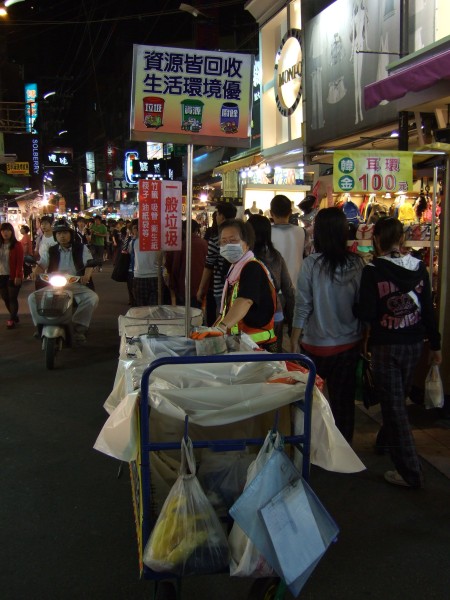
We even snapped a photo of just the street to prove how much cleaner it is compared to China, during a brief moment when a stretch of the night market was less crowded:
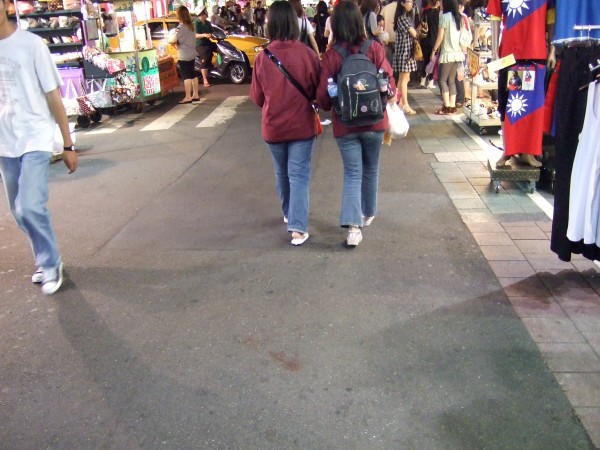
Pretty amazing. That’s something you’d never see in China, especially in crowded night markets filled with seas of people who litter like it’s nobody’s business.
Elena pays particular attention to how a city incorporates trees and plants into its overall environment, and Taiwan was pretty good in general:
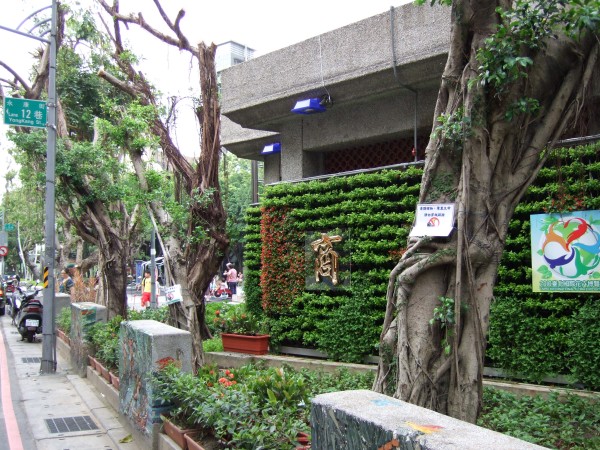
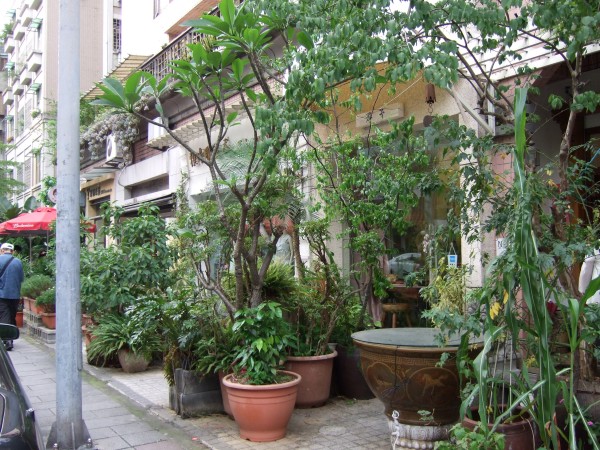
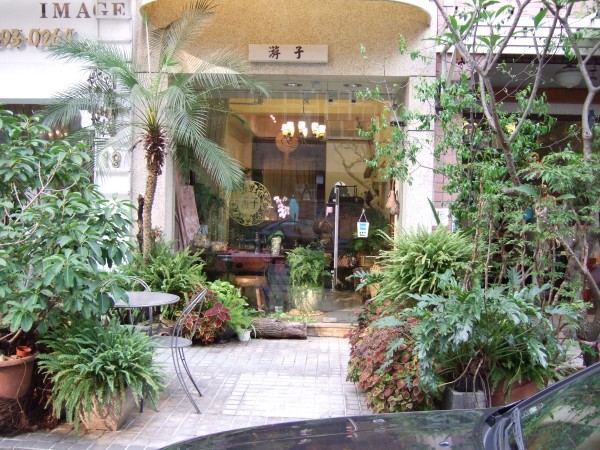
Even those who lived in places that had no room for planting anything, went out of their way to do it anyway, which shows how important plants are to them:


Elena really loves gardening and plants, so we had to visit the biggest flower market in Taipei. It was gigantic, Elena was like a little kid in a candy store:
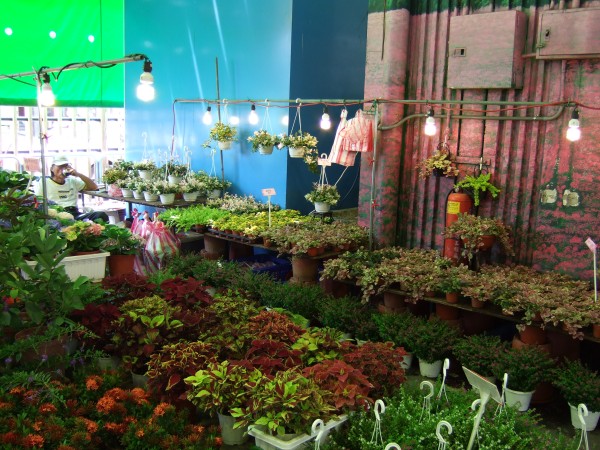


The vendor stalls continued on and on, and lasted for a few blocks. I’ve never seen a flower market that big before in my life–it was just insane. Elena wished she had a gigantic backyard so she could haul back everything she ever wanted to grow. For now, she’ll have to be content with our modest apartment balconies.
When we strolled through a park, we noticed the squirrels in the park were pretty bold–running up to people to eat food out of their hands:

…
Elena and I both noted that girls in Taiwan are in general better looking and better dressed/made-up than girls in Hong Kong or China–it’s not just a vague impression–we actually analyzed the facial features and the number of attractive girls are indeed more numerous, and they don’t include the ones that pile on so much makeup that you could barely see what the person actually looks like. We have a low tolerance for caked on makeup, fake eyelashes, heavy eyeliners and eyeshadows…etc–they just look so fake and off-putting. We discussed the psychology behind this behavior, and I guess it comes down to this–if you’re an unattractive girl and piling on the makeup can turn you into someone significantly more attractive, even if the the price you pay is to lose any sense of naturalness about you–essentially wearing a mask that looks nothing like you, would you do it? I guess it depends on your priorities, values, and what your idea of personal pride and self-esteem is.
One day we were just walking down the street, and we saw some photographer taking photos of this person who to me looked like a transvestite, because she just looked so odd, and upon closer look, we realized it was Bai Ling, who was in Taiwan maybe promoting something. I’m not really a fan of hers, since she’s the type that tries so hard to be risque and wild that it just comes off as cheap attention-whore behavior (plus she’s likely certifiably insane based on the kind of stuff she says during interviews). Elena and I couldn’t be bothered to take a photo of her, but my mom did. If she was really hot, then it’s possible to overlook her personality, but being kind of awkward-looking (what she’s done to herself, not how she naturally looks), there was just no point.
…
Elena and I visited Taichun for a day since people keep telling us how cities outside of Taipei are slower paced, less hectic, more hospitable, and the people kinder and more sincere. We were not prepared to find none of it true, except for the slower paced part. The places we visited had noticeably worse attitude and quality of service–from taxi drivers, restaurant waitresses, to ticket window clerks. There were also less interesting places for shopping and food, and there’s no subway system either. We were disappointed overall, and I think we’d much prefer to stay in Taipei in the future. Speaking of quality of service and attitude, we were surprised by how good they were in Taipei–people would go out of their way to help you, and they were so friendly that we just couldn’t believe it. It’s different from the ultra-polite Japanese–sort of like a more humanized version where the politeness is combined with sincerity and friendliness–basically less fake and more real.
Though there isn’t as much to see in Taichun, it still has similar night markets and shopping districts like the ones in Taipei, though much smaller in scale and not as glamorous (nothing like Taipei’s 101 shopping mall). This little shopping district in Taichun was kind of cozy:

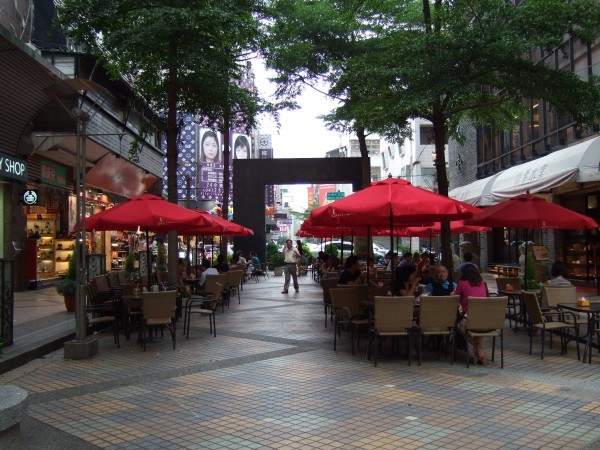
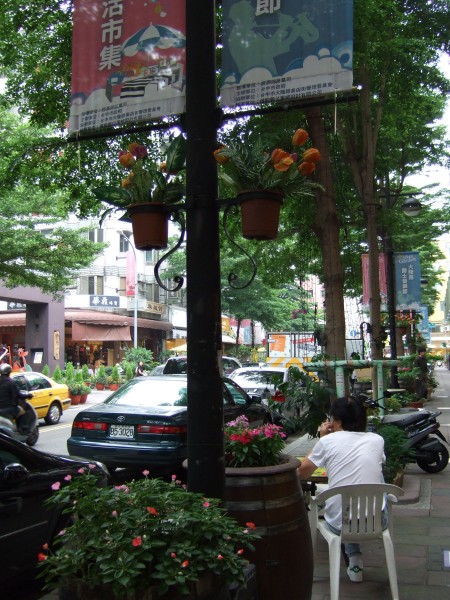
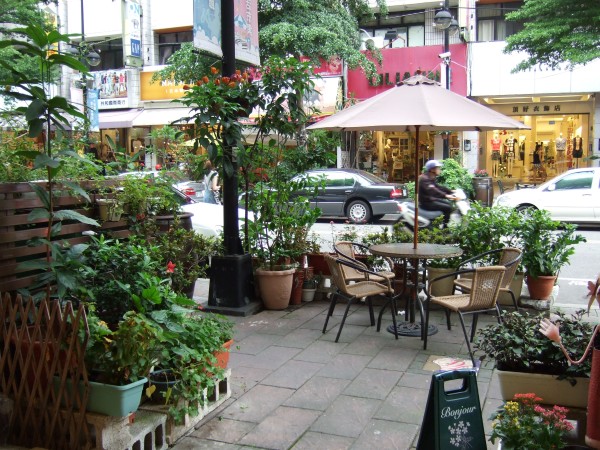
…
While browsing the book/CD/DVD stores in Taiwan, I bought three CD’s:
White Shoes & The Couples Company / Self-titlted – An interesting retro 70’s pop band from Indonesia, which is actually now signed to Minty Fresh Records in Chicago. The music is a little bit like the first couple of albums from The Cardigans, but more willfully retro. They even wear 70’s clothes exclusively, which is kind of unfortunate because it’s perhaps the worst decade for fashion ever.
Daiqing Tana (代é’塔娜) & Haya Band / Silent Sky (寂é™çš„天空) – An intoxicating mixture of Mongolian ethnic folk, world fusion, and modern songwriting/production. Daiqing Tana’s voice is beautiful and soulful, while the music is atmospheric and haunting.
He Xuntian (何è®ç”°) / Tathagata (如æ¥å¦‚去) – New age/world music that uses Buddhist philosophies are its main theme. I find most new age/world music to be laughably bad because they tend to be really shallow and exploit whatever culture they latch on as a gimmick, but this is much better than the usual stuff from that genre, as the producer is a respected composer and the ethnic leaning are authentic and interesting–in other words, it’s not just some white guy trying to play ethnic music from a culture he barely understands. The music in Tathagata is also not like typical new age/world music, which is essentially easy-listening music played with ethnic instruments in exotic scales–Tathagata actually tries to explore some central ideas in Buddhism and the music has muscle and ethereal beauty combined.
…
While in Taiwan, I talked to some insiders about the state of the music industry there currently, since I was a part of that scene briefly about fifteen years ago. Back in the mid-90’s I went back to Taiwan to pursue a career in music, and I sold a song to a famous popstar at the time, and also wrote some songs for other popstars, but they were rejected because my style was too indie/underground/alternative/edgy. I befriended the underground bands around at the time like Assassin (刺客), Groupie (骨肉皮), and that was the crowd I hung out with during my stay there. I observed how anything that wasn’t commercial mainstream music had no chance of making a decent living doing what they love, and how bland and mindless the public’s taste was in general when it came to music. When one of the arranger/producers told me how I ought to use specific piano patches from a specific keyboard workstation because that was the sound the public was familiar with, or how many “songwriters” just take the A verse from another song and mix it up with the B verse from another song and voila! A new song. I was thoroughly disgusted, and decided that Taiwan’s music scene was still too backwards and I’d rather be a small fish in the ocean (the States) than be in a small pond (Taiwan). There also wasn’t much of a comic book industry either, and at that time, music and comic books were my main focus, so I really didn’t see a point in staying (despite the fact I was really in love with a girl (who owned a bar and was a bass player) and we had just started dating).
I’ve always been curious about how my life would’ve turned out if I had stayed in Taiwan–not because I think I could’ve had a brilliant career there as a musician or comic book creator, but because I think it would’ve lead to some really memorable and interesting life experiences. Life in the States moves a lot slower, and things don’t change that much over time, but in Asia, the entire social landscape is always changing so fast, and you experience a lot more in a lifetime than you would in the States (relatively speaking, as it ultimately still depends on your lifestyle).
Anyway, what I learned was that the music industry has changed a lot, just like it has all over the world due to the internet, MP3’s, advancement of DAW computers for music production…etc. Pretty much all the big recording studios have closed down in Taiwan, as everyone now just produces in their own home studios or small private studios–even the A-list musical artists. Mainstream music isn’t making any real money and the popstars all get their income from TV appearances and commercials, concerts, merchandising…etc. The ones who are purely musicians and producers are all having a hard time as there’s no money to be made in selling CD’s, and many turn to scoring for films, TV shows, video games, and so on. But what’s interesting is that in the last decade or so, indie/underground music has exploded, and while they don’t make any money selling CD’s either, they are strong in live performances, so live houses are their main source of income. Some also turn to teaching music in schools or privately. Essentially, it’s much like how it is everywhere else in the world–the music industry has completely changed in the last ten years or so. The fact is, even if I stuck with music, I would probably never live as comfortably as I did working in video games and CG, and it’s debatable if I’d have been happier, since all the business and politics of the music industry would take away from the joy of making music.
It’s kind of pointless to ponder too much about how my life could have been, especially that if I had stayed in Taiwan, I’d have never met Elena, and I wouldn’t have the happy marriage I have now.
…
I got to see some of the siblings I have on my dad’s side while in Taipei. The last time I saw them was about fifteen years ago (and prior to that I have never met any of them except for the two oldest ones that I lived with for a few years before I moved away to live with my mother and step-father. The two oldest girls have no memories of me even though I took care of them when they were babies and toddlers). Last time I saw them, the oldest was sixteen, and now she’s thirty-one. In the past, we haven’t really had a chance to have any kind of a relationship because I haven’t been a part of that family since age nine, not to mention I grew up in the States while they were in Taiwan. Now we’re all adults, and the internet having changed the social dynamic of our society, it’s actually possible to have a relationship even if we live in different countries.
I have sometimes wondered how my life would’ve been if I had stayed in Taiwan and lived with my dad and step-mom instead of moving to the States with my mom and step-dad. I don’t know if I would’ve been allowed to stay with that family anyways when my dad abandoned everyone and started another family (his third). I mean, sure, I was the half-brother to the five kids, but would my step-mom have wanted me to remain with them, or just sent me to live with my grandparents since it would’ve been impossible to raise six children on her own? She’s really an amazing woman since she managed to raise all five kids by herself, and they all turned out well. Perhaps their lives could’ve been a little easier if I was there to share the burden and be the protective big brother. Or maybe I’d just add to the mess and make things worse–I’ll never know. Although we share the same father, we don’t really know much about each other–practically strangers. It would be interesting to get to know them and see where it takes us. I found them on Facebook the other day, so that’s a good start I guess.
…
Before we arrived in Taiwan, we spent a couple of days in Hong Kong, and I visited KingSound Headphone Shop (金è²è€³ç’專門店, http://www.headphonehk.com) and tried out a few headphones I’ve always wanted to test. I even brought my Denon AH-D7000 and Westone 3 with me on the trip so that I could do comparison tests with it. I have a CD that I use especially for testing studio monitors speakers and headphones, which starts off with pure sine waves at various frequencies–this is to test how neutral/flat something is, and it goes from 16Khz all the way down to 30Hz, not in a sweep, but repeating important frequency tones 3 times at each interval. Then I have all kinds of music that ranges from orchestral, electronic, jazz, rock, acoustic/voice, and so on, each track testing specific things like sub-bass presence, bass texture/detail, neutrality, instrument/voice body/texture, percussion impact/texture/detail, soundstage, shrillness, muddiness…etc. On the Zen player, I also have these same tracks.
Here are some thoughts on the models I listened to:
Sennheiser HD800 – I have listened to the HD800 twice (once in Hong Kong, and once in Taiwan), and I never really warmed up to it. Its clarity and resolution sounded artificial to me instead of natural, and it had no authority in the sub-bass region (before anyone starts mentioning amps, I listened to it with the SPL Phonitor and the Corda Symphony.2, both of which are excellent amps). I’m one of those people who simply cannot consider a pair of headphones to be “amazing” or “the best of” if it’s lacking neutrality in a chunk of the frequency range. A amazing pair of headphones should sound like a full-range speaker system that reaches down to 30Hz and remains substantial and authoritative–anything less than that is not “amazing” to me. It’s sort of like if a girl is really hot with an awesome body, but her ass is flat, barely able to fill any pair of jeans–would that still be considered an amazing body? Not in my book. Even the HD650 has more sub-bass extension and weight, and it costs far less than the flagship HD800 model. I understand that there’s a portion of people whose idea of neutral bass is in fact anemic bass to me, and I stand my ground on the issue because anyone who’s ever heard a full-range speaker system that reaches down to 30Hz or lower, will know that neutral bass in in fact quite authoritative and substantial. There are headphones out there that can reach down low and feel very authoritative–for example, the Stax 007MKII, Denon AH-D7000, Audio-Technica ATH-M50, ES-10…etc, so it’s not like the HD800 is somehow limited by physics–it was a choice the engineers at Sennheiser made.
AKG K701 – I have been recommended the K701/702 many times before and I finally got to hear one in person. I actually liked it a lot, as it sounded smooth, detailed, open, and articulate, but the caveat was the anemic mid-bass presence. Although the K701’s sub-bass is well extended, its lighter mid-bass turns the overall presentation into something less than ideal. It’s really a shame because that’s the only real weakness it has, and if it had more mid-bass presence, it could very well be one of the best headphones out there. The K701 is very comfortable, and visually it’s one of the best looking headphones out there.
AKG K601 – I agree with the people who say it’s a more balanced sound overall than the K701, but neither had the authoritative bass I’m looking for. Aside from the lack of authoritative bass presence, I really liked both of the AKG models.
Ultimate Ears Triple.fi 10 Pro – The Triple.fi sounded quite warm and didn’t have the kind of articulation/clarity/air I prefer (which is one of the things I don’ t like about the Westone 3). The sub-bass wasn’t as extended as could be either.
Westone UM3X – The UM3X was more balanced than the Westone 3, without that really bloated mid-bass, but it’s still not there in terms of clarity and air.
Etymotic ER-4P – I really liked the ER-4P because it’s got great clarity and articulation, but its bass was just not substantial enough, which is a shame, because it’s not something you can just EQ with your MP3 player, since typical EQ’s on players do not extend into the sub-bass region.
Of all the IEM’s I’ve tried to date, I think only the Shure SE530 got close to having a good bass extension without that bass bloat like so many IEM’s (the W3 for example). I would love to try the JH13/16 one day since they’re probably the only IEM’s capable of that big full-size headphone sound.
SPL Phonitor – I was lucky that there was a Phonitor available in the store, and I mostly wanted to test out its crossfeed feature. After trying out its crossfeed, I actually preferred the $27 plugin I bought not long ago called Isone Pro, which sounds much more realistic to me in terms of simulating a pair of speakers in a room. As for all the fancy electronics like the converter or the amps inside the Phonitor, I have to say I really feel that these thousand dollar+ headphone amps are total overkill, especially if the headphone is low impedance in the first place (like the D7000). I’ll talk more about amps later when I get to the Corda Symphony.2.
While in Taiwan, I called and reserved listening time at Music Hi-Fi Co. (音悅音響, http://www.hifi.com.tw) in Taipei, and here are some thoughts on the models I tested (all dynamic headphones were amped with the Corda Symphony.2, and I even A/B’d the Symphony.2 against straight out of the Creative Zen’s headphone output):
Stax 007 MKII + SR-717 – I have seen people comment that once you try electrostatic, you might get hooked, and being a musician who’s familiar with the concept of condenser microphones, which uses a similar concept, I had some idea of what to expect (and I do prefer the condenser mic sound overall to dynamic mics, since it’s more nuanced, detailed, sensitive, and textured). Originally I had hoped to test the 4070, but it’s a special order only item at the store. They suggested the 007MKII instead, saying that most people prefer it over the 4070 anyway because the 4070 isn’t as comfortable, and the 4070’s sub-bass isn’t all that more prominent, while sounding a bit more congested since it’s closed-back (I don’t trust what they say since they could be just trying to get me to buy the 007MKII instead). The 007MKII was very comfortable–snug like the DX1000 and W1000X, as opposed to a very light clamp like the D7000.
I loved the sound of the 007MKII. It’s so amazingly natural sounding that I couldn’t help but smile from ear-to-ear. Voices and instruments sounded so textured, full-bodied, yet clear and smooth, with no hint of any unnatural coloration, sibilance, artificial dip or spike in any frequency range. Dynamic headphones just pale in comparison, sounding artificial and forced–like the engineers used all kinds of tricks to push, pull, squeeze and mold the sound into their ideal, but leaving all kinds of fingerprints behind in the sound–little anomalies here and there–like the fake Hd800 sound, or the strangely distant treble on the DX1000, or the somewhat sharp upper mids/lower treble of the D7000 and DX1000…etc.
What else is amazing about the 007MKII is that even though 30Hz is a bit rolled-off, it doesn’t not seem to take away the sub-bass authority of the headphone–the sub-bass remains full-bodied, rich, tightly controlled, textured, and I couldn’t figure out how that’s possible. It slams and punches and booms just as well as the D7000, while sounding perhaps even more natural at it, and still matching the power, heft, and lushness of the D7000.
The treble is articulate and smooth, and makes dynamic headphones’ treble seem kind of squeezed and fake. It’s not as sharp but it’s very clear and defined, whereas most dynamic headphones’ treble sounds EQ’d in comparison. The mids are also so smooth and textured–when I listened to orchestral string, I can actually hear and “feel” the horsehair of the bows rubbing against the strings–something I have never heard or felt with any dynamic headphones–ever. Voices also sounded so natural–it’s almost like dynamic headphones’ reproduction of voices are like girls who are only pretty after they’ve piled on the makeup, while the voices I hear on the 007MKII are naturally beautiful–no need for makeup at all.
I also found that because the 007MKII sounds so natural, it doesn’t need to be lush in any artificial manner–its naturalness is just naturally lush–so hard to describe it, but oh so beautiful to listen to.
I was really hoping that electrostatic headphones are just all hype and audiofool insanity, so that I don’t have to go down that expensive road to reach my audio nirvana, but goddammit everyone was right–the Stax is no joke–it’s the king–the one headphone to rule them all. Now I’m facing the fate of my bank account being short thousands of dollars sometime in the future.
Here’s the 007MKII wih the SR-717 amp:
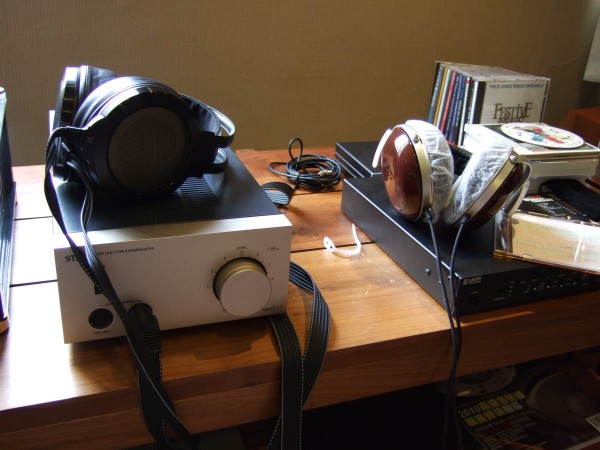
Victor/JVC HA-DX1000 – I finally got to test a pair of DX1000 against the Denon AH-D7000, and right off the bat, the treble just sounded odd–it’s kind of distant and muffled, but still articulate–as if the treble existed in a different plane of space. The sub-bass wasn’t as extended as the D7000, with 30Hz being rolled off–in fact the right driver started buzzing at 45Hz and lower (D7000’s 30Hz remains just as prominent as the other bass frequencies, with no sign of roll-off, and no sign of distortion). My M50’s 30Hz is also struggling a bit, with a little bit of distortion, but seems better than the DX1000. Even if the DX1000’s right driver wasn’t misbehaving at sub-bass frequencies, the 30Hz area was roll-off anyways.The mids were fine and I liked it–it’s natural and soothing, but strangely enough the upper mids/lower treble was slightly sibilant and sharp, which made the distant treble stood out more. Comfort wise I liked it a lot too–nothing to complain about. It’s more snug than the D7000, which isn’t good or bad–just depends on taste. Some people like the feeling of snug pillows around the ears, and some like a barely there light clamp. If I had to choose I’d choose D7000. The DX1000’s treble was just too weird and its bass not as extended as the D7000, although the mids are better.
Audio-Technica ATH-W1000X – The W1000X is better balanced than the DX1000 to me–its treble, upper mid/lower treble, mids, bass, and sub-bass are fairly balanced. 30Hz is also a bit rolled-off just like the DX1000. I think the overall sound is probably more natural than the D7000, but the sub-bass isn’t as authoritative. Comfort-wise I like it a lot too–also snug like the DX1000 as opposed to the D7000’s barely there super-light clamp. I find that I prefer auto-adjusting headbands since you don’t have to fiddle with anything or accidentally change the notch setting.
Audio-Technica ATH-ES10 – For a portable, the ES-10 has surprisingly substantial sub-bass–very similar to the M50, with both able to almost match the D7000 all the way down to 30Hz (although the D7000 does it effortlessly, while the two AT models struggle a little bit more). In fact. The ES-10 and the M50 sounded so similar to the point where I wondered if they use the same driver. It’s a pleasant and warm sound without any sibilance, but not as articulate or airy as I’d like. Being a portable on-the-ear is fine since it’s actually pretty comfortable, but I still prefer to not have something pressing on my ears at all. I wouldn’t pick the ES-10 over the M50 since the M50 costs less than half but sounds so similar, and is more comfortable, being full-sized, not to mention it folds down and is quite portable.
Denon AH-D5000 – There are some people out there who feel the D5000 is actually superior in sound quality to the D7000, despite the D7000 being the flagship model and costing a lot more. After comparing the two, I feel the D5000 isn’t at the same level as the D7000. With typical music it may be hard to tell the difference, but a simple sine wave test shows that it isn’t as prominent at 30Hz as the D7000, with some roll-off, and the bass also isn’t as well controlled, punchy, or clean as the D7000. The D7000’s treble is more articulate and clear, and the mids are roughly the same in both. The upper mids/low treble–which is where the sibilance plays (6Khz~8Khz), is also roughly the same on both. So basically the D7000 improves the D5000 in just about every way, while the D5000 isn’t better than the D7000 in any way to me. Both have similar shorcomings (the upper mids/lower treble being a bit sibilant and fatiguing, and the mids are recessed), so if you didn’t like one, you’re not going to like the other.
Here’s the D5000 and the Stax 007MKII behind it. The D5000 isn’t as eye-catching as the D7000 since it doesn’t have the glossy piano finish (but otherwise are identical visually), which makes the D7000 look much classier:
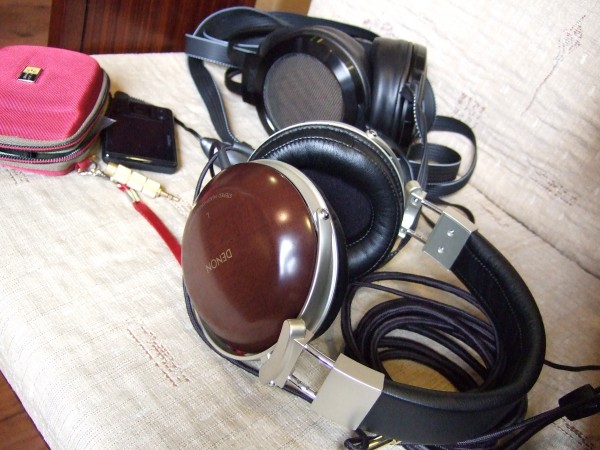
Grado Alessandro MS-Pro – Terrible ergonomics. Why would anyone design headphones that sits on your ears uncomfortably like this? While it’s sounds pretty ok in general (nothing to write home about though, especially in the company of all these excellent headphones), I just couldn’t stand the ergonomics.
Corda Symphony.2 – OK, this is where I might lose all credibility (or maybe open some eyes/ears with what I’m about to say). I actually tested my D7000 amped by the Symphony.2 and straight out of my Creative Zen’s headphone out, and I listened and listened and listened, and you know what? If there are any differences, they are so minute that they just aren’t night and day obvious. The Symphony.2 sounded just a bit smoother, dimensional, and better controlled–like a tiny bit more refined and dynamic version, but this is if I really concentrate to hear the differences, and I’m a composer/sound designer. The average person will not be able to hear the difference. But I realize that the D7000 is only 25 Ohms, so it’s very easy to drive, thus probably doesn’t benefit as much from a dedicated headphone amp like the Symphony.2 as high impedance headphones would.
Before I had ever heard any dedicated headphone amps. I had always been skeptical, feeling that if they colored the sound in anyway, then they are just like microphone preamps where different models have different flavors, but nothing like the differences between the headphones themselves. While really amazing mic preamps like the Great River or DAV-BG models do have a larger-than-life sound, they ARE coloring the sound, in a good way–like how audio engineers use EQ’s and compressors. I’m sure that when headphiles go on and on about headphone amps, they are talking about this desirable coloration just like how musicians and audio engineers talk about mic preamps, and I can totally understand that. But at the most basic, the headphone itself needs to sound damn close to the sonic signature you desire, and the amp is just extra icing on the cake–it should not be something you depend on or use to force the sound of any headphone, just like you can’t make a crappy mic sound amazing with a killer preamp, but you can make a good mic sound awesome with a killer preamp.
On that note, neither the Symphony.2 or the Phonitor blew me away. If they had that larger-than-life desirable coloration like the most coveted mic preamps, then I’d understand all the hoopla about headphone amps, but they more or less sounded so much like the headphone out of my Zen player–just slightly more refined, that I don’t see the need to spend over a grand for that tiny bit of difference. Maybe when I hear a very nicely colored amp I’ll changed my mind, just like how I’ve been wanting a Great River or DAV BG mic preamp for their beautiful larger-than-life sound. Until then, they represent the kind of diminishing returns I hate about high-end gear.
Here’s the Symphony.2 amping the DX1000 (I brought sanitary covers for the earcups with me so the store owners will be more likely to allow me to test their expensive high-end models:
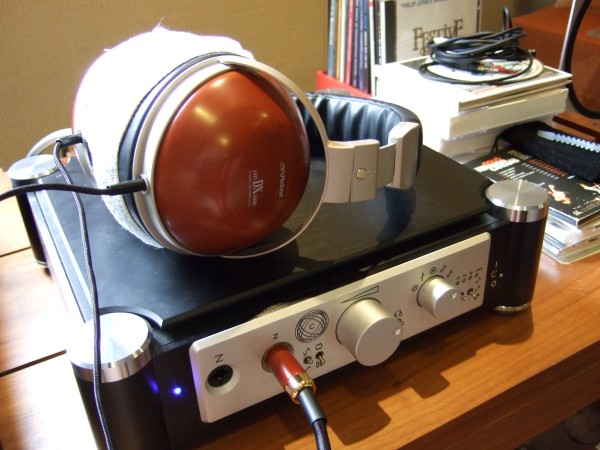
At the moment, I’m still looking for my ideal pair of headphones, and on my short list are these models:
Audez’e LCD2
Ultrasone Edition 8
Beyerdynamics T1
Stax 007MKII
JH Audio JH-13/JH-16
All of them cost at least a grand, and are considered some of the finest headphones ever made in their respective categories. The only one on that list I have heard is the Stax 007MKII, and as already mentioned, I absolutely loved them. They are also the most expensive by far. I might go for the LCD2 next as it’s developed quite a bit of a reputation immediately upon its release as “the” headphone to rule them all.
…
I’m getting close to finishing Uncharted: Drake’s Fortune, and it’s starting to get on my nerves. The way the game progresses gets ridiculous, as there are bad guys everywhere, even in places that took Nate’s amazing skills to reach–places that are supposed to be secret and undiscovered. If Nates’s such a clever treasure hunter, then why are the incompetent bad guys always several steps ahead of him, and how is it that they are able to reach such difficult to get to places? What, all the lowly guards are expert climbers and acrobats like Nate? When a game jumps the shark this way, I just lose interest because all narrative credibility just goes down the drain, and you feel like the people behind the game just didn’t give a shit if their narrative made any sense. I’ll probably still finish the game, but only because I’ve gotten pretty far already.
…
Quickie Movie/TV reviews:
The Pacific – Definitely not as good as Band of Brothers. They should have followed the same group throughout the series instead of three separate characters, as that diluted the power of the narrative and how much we cared for the characters. I actually found the episodes away from the battlefield to be the most interesting, such as episode in Australia where the boys were just chasing skirts. I was also underwhelmed by Hans Zimmer’s score, as it was so by-the-book,bland and derivative that it was perhaps one of the most boring and irrelevant scores he’s ever composed.
V (season one) – I got so turned off by the writing that I didn’t even bother watching the season finale. That whole subplot with the mom and son is just so arbitrary and contrived that I wanted to slap some sense into the writers. It’s a cheap way to create unnecessary drama–that B.S. reasoning for why they are having a communication problem. Any sensible and intelligent parent would have pulled the son aside early on and told him what was happening and kept him the hell away from the V’s. The explanation that if his behavior changed the V’s would’ve noticed was also a steamy load of crap. Why couldn’t the boy just say his mother finally put her foot down and he’s forbidden to interact with the V’s–end of story? The complete lack of security measure inside the ships are also laughable. No security cameras and audio? The Fifth Column moles can just be in any empty room and openly communicate with the resistance as if no one is watching or listening? The medical examination chambers have no security cameras at all? Who comes up with this idiotic mess? In this day and age, when TV shows are outdoing each other in terms of artistic integrity, innovation, and technical achievements, the V remake is an embarrassment. It’s as if the creators and writers have slept through the entire television revolution that began with The Sopranos, and they think they are still living in the early/mid 90’s.
Synecdoche, New York – I really wanted to like this movie because it’s Charlie Kaufman’s directorial debut, but it was just a pretentious and self-pitying mess that comes off as whiny, depressing, and ultimately goes against all the things that are beautiful about our human existence. I can understand and respect the film’s commenting about failure, mortality, loneliness, insecurity, disappointments, and so on, but when everything in the film paints the human existence as glass half empty–no, a glass of dark abyss that’s soul-crushing, you have to wonder if Kaufman has anything in common with the rest of us except maybe the manic depressives and the suicidal. And I’m saying this as a passionate creative person who has been struggling and fighting all of my life to be great at what I do, and who’s lived a life thus far that’s contained regrets and disappointments and failures, not to mention I’m terrified of dying, as I have so much I want to accomplish in my life time that even several lifetimes would not be enough.
In some online discussions, it seemed the people who loved this film will deride anyone who didn’t like the film, accusing them of being shallow, unable to understand the struggle of the artist, or unable to see how Hoffman’s character is in fact all of us, having the same fears, insecurities, misery…etc. I think that’s such a snobby thing to say. Hey, I didn’t like this film and I’ve been pushing myself to be a great artist, composer, writer/director and photographer since puberty, and I starved for my dreams for many years, barely surviving on the shitty money I made as a starving artist and writer-all because I believed in myself and fought for my dreams. I continue to fight for my dreams and push myself hard to accomplish something I can proudly leave behind when I die. All those people who are making such accusations–how hard have YOU fought for your dreams and artistic ideals in your life?
The problem with this film is that there is no silver lining, no redemption, and nothing worth living for at all–everything is bleak, meaningless, and disappointing. While there are things I can identify with in the film, the severity of the main character’s neurosis just reminded me how well-adjusted and normal I actually am in comparison, and that his entire life was this incessant whining and crying over spilt milk, while all the things that inspire happiness and fulfillment are completely absent. It’s one thing to try to convey something honest about life, but it’s a different thing altogether when the life you depict is so uninspiring and pathetic that we want nothing to do with it. It’s also a misleading portrayal of struggling artists, because it only depicts the negative without mentioning any of the positive. If living a life of creativity is so miserable and that’s all there is, then there really wouldn’t be many creative people left in the world. Listen, if I ever become anything like the main character in this film, then please, somebody shoot me and put me out of my misery. In fact, if Charlie Kaufman continues to make films drenched in self-pity and misery like this film, then someone ought to put him out of his misery too because his life is probably filled with only pain and nothing else. Perhaps he should switch to making films about the Holocaust, genocides, wars, or senseless and violent crimes against humanity, as they are also filled with pain and hopelessness. Wait, no–even some of those films can be inspirational and contains beauty and hope.
The Book of Eli – It wasn’t nearly as bad as some people made it out to be. It was in fact pretty entertaining, and was not as preachy as I was afraid it might be. You do have to engage your suspension of disbelief, especially when you learn about Eli’s handicap towards the end, but it could have been far cheesier in lesser hands.
Hey Robert! Glad you enjoyed your trip to Taiwan! All that food looked absolutely delicious, it was very inspiring to see it too.. all the colours and shapes.. amazing.. Well, hope you are well rested and comfy back at home now. Keep well to you both..
Such an interesting read on Taiwan!